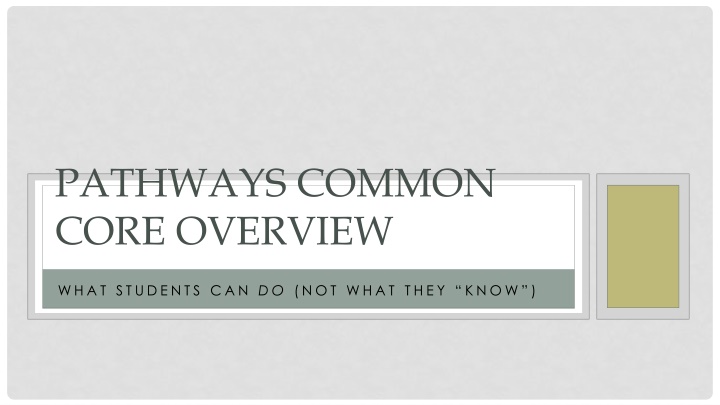
Common Core Standards and Instructional Shifts
Explore the overview of Common Core standards emphasizing what students can do rather than what they know. Discover the two sets of standards for English Language Arts/Literacy and Mathematics, along with important instructional shifts in both subjects. Dive into the essential elements of ELA instruction focusing on text balance, disciplinary knowledge, complexity, questioning, writing, and vocabulary. Learn about instructional strategies like close reading and details about the Smarter Balanced Assessment process.
Download Presentation

Please find below an Image/Link to download the presentation.
The content on the website is provided AS IS for your information and personal use only. It may not be sold, licensed, or shared on other websites without obtaining consent from the author. If you encounter any issues during the download, it is possible that the publisher has removed the file from their server.
You are allowed to download the files provided on this website for personal or commercial use, subject to the condition that they are used lawfully. All files are the property of their respective owners.
The content on the website is provided AS IS for your information and personal use only. It may not be sold, licensed, or shared on other websites without obtaining consent from the author.
E N D
Presentation Transcript
PATHWAYS COMMON CORE OVERVIEW W H A T S T UD E N T S C A N D O ( N O T W H A T T H E Y K N O W )
THE STANDARDS: HTTP://WWW.CDE.CA.GOV/RE/CC/ Two Sets of Standards: English Language Arts/Literacy Apply to all subjects, not just ELA Mathematics o Grade-Level Content Standards o Standards for Mathematical Practice
ELA SHIFTS IN INSTRUCTION #1: Balancing Informational and Literary Texts By high school, students should read 30% literary and 70% informational texts. #2: Knowledge in the Disciplines Content area teachers must teach literacy. Students learn content by reading about it. #3: Staircase of Complexity Students need to read more complex texts. Teachers should emphasize depth over breadth.
ELA SHIFTS IN INSTRUCTION #4: Text-Based Questions Teachers should pose questions that students can answer only by referencing the text. #5: Writing from Sources Student writing needs to emphasize use of evidence to inform or make an argument. #6: Academic Vocabulary Teachers should focus strategically on common cross-curricular academic words (analyze, tangent), instead of isolated content- specific words (isotope, onomatopoeia).
INSTRUCTIONAL : CLOSE READING Small, worthy sections of complex text Text gets at the essential learning Each read / re-read has a different purpose Process includes: o Annotation Strategic focus on academic vocabulary Text-dependent questions o o
SMARTER BALANCED ASSESSMENT: 2014 FIELD TEST Pathways testing window: April 21st-May 2nd Google Chromebooks Up to 4 hours per grade level No student scores given No school score given Non-adaptive assessment Focus is on technology infrastructure
SMARTER BALANCED ASSESSMENT: 2014 FIELD TEST Will assess students in Grades 3-8, 11 All eligible students are expected to participate 25 questions in ELA and 25 questions in Math, plus one performance task Grade 11 students may also participate in the Early Assessment Program Traditional paper and pencil CST (STAR) for Science in Grades 5, 8, 10
SMARTER BALANCED ITEM TYPES Selected Response Computer Enhanced Constructed Response Performance Task
PERFORMANCE TASK (5THELA) Student Directions: Part 1 (35 minutes) Your assignment: Honus Wagner was a baseball player in the early 1900s and is considered by some to be the world s greatest shortstop. You will view and read several sources about him and write a narrative story from the point of view of Honus Wagner, using the information you learned. Steps you will be following: 1) Watch a video and read a fictional narrative and a biography about Honus Wagner. 2) Answer questions about the video and texts. 3) Plan, write, and revise your narrative.
CURRICULUM: HOW WILL THIS IMPACT THE CURRICULUM THAT I USE WITH MY CHILD? MOST existing materials can still be used CCSS is more about method than materials Focus on worthy and complex texts and incorporate informational texts across the subject areas (Appendix B) New and truly aligned curricula are still being developed PCS will purchase some new materials to have available in the school libraries Focus on engaging the habits of mind described in the shifts discussed above
WHATS NEXT? On-going parent information sessions Fall parent training on specific teaching methods: Close reading Text-dependent questions Mathematical reasoning Monthly student assignment sheets for elementary-middle grades are already aligned to CCSS and can be used as a guide Subject area experts are working to assess current library resources and make new purchases Website resources are being updated
QUESTIONS What do you still need to know? Did today s presentation address some of your concerns? As the day-to-day teacher, in what areas do you need or want more training?
